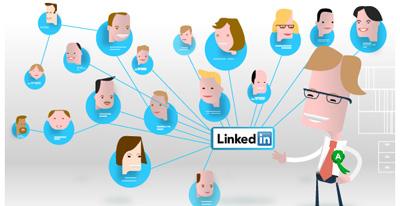 If your organization or PR client seeks to promote its LinkedIn company page, don’t overlook the value of the company’s employees. Employees may be the most important tool for increasing page views, engagement and placing the company in front of potential customers on LinkedIn and other social networks.
If your organization or PR client seeks to promote its LinkedIn company page, don’t overlook the value of the company’s employees. Employees may be the most important tool for increasing page views, engagement and placing the company in front of potential customers on LinkedIn and other social networks.
When employees share company updates, the content becomes visible to their networks, vastly increasing reach. Over and above sharing, each employee profile in social media networks can function a bit like a product page, especially if the employees include links to the company webpage. Employee’s popular social media posts can gain attention for the company and new business. The network of people following employees is especially valuable for companies offering professional services.
The numbers may surprise you. Employees have 10 times as many social followers as their company and garner more engagement, according to LinkedIn. While only about 2% of employees share content their companies post, they’re responsible for 20% of overall engagement for that content.
Companies using LinkedIn successfully encourage their employees to:
- create quality profiles that reference the company,
- share company updates,
- recommend ideas for content,
- suggest posts to comment on and share,
- and – perhaps most significantly — to write posts.
Companies with visually appealing content can gain similar advantages by encouraging employees to post images on social media networks like Pinterest or Instagram.
Tips for Involving Employees in LinkedIn
These are some key steps for involving employees, according to experts.
Training. Companies that show employees how to build compelling profiles and share company updates will gain greater access to potential customers through the employees. Offering incentives and friendly competitions can help encourage posting and sharing.
Lead by example. If executives begin posting more content, employees will likely follow suit and publish their own content.
Content ideas. There should be no shortage of content ideas. Entry-level employees can share what they’re learning and veteran executives can write about their insights, their predictions and current industry trends. It’s important to let employees write about what they feel passionate about with no filtering by the company.
The Dell Example
Dell is a prime example of a company employing LinkedIn to good effect, says LinkedIn Executive Editor Daniel Roth. Last year, it recruited 43 employees to regularly publish posts on LinkedIn and SlideShare. Rather than giving them a script, Dell told employees to write about what’s important to them.
Dell gained authentic voices and provided potential customers an inside view of the company, thereby improving the atmosphere for locating customers and closing sales.
Roth notes that Dell Senior Social Media Strategist Nazli Yuzak revealed an essential point: “People buy into other people more than buy into products or services.”
Dell Executive Director of Marketing Kevin Green wrote about the 5 Things the Death of My Father Made Me Change. He expected the post would circulate only within his network and only close associates would comment. Within a few weeks, it had achieved more than 200,000 views and a thousand comments. Green became the most viewed Dell employee on LinkedIn after CEO Michael Dell.
Don’t Fear Publishing
Many companies take what they think is the safe approach of remaining quiet online. Some even block employee desktop access to social networks. Those companies fear that employees will waste time socializing or job hunting. Some companies may also fear a visible employee might share sensitive information or become more poachable to competitors. In fact, blocking access or discouraging profiles lowers trust and damages morale.
The real dangers are that valuable employees will leave because they want a higher profile and that potential customers will turn to competitors that encourage their employees to post and engage on the network.
Companies that don’t encourage their entire workforce to be on LinkedIn are missing a valuable opportunity to forge improved connections with potential customers through their employees.
Bottom Line: A company’s employees are among the most valuable resources to promote the company and its products on LinkedIn. By encouraging employees to share content about the company and produce their own posts, companies can attract more customers to their corporate LinkedIn pages, which can prompt more sales leads and closings. The same principle applies – even more so – to not-for-profit organizations. Most employees of non-profits are passionate advocates who can spread the word about the organization and connect their friends to the organization.
William J. Comcowich founded and served as CEO of CyberAlert LLC, the predecessor of Glean.info. He is currently serving as Interim CEO and member of the Board of Directors. Glean.info provides customized media monitoring, media measurement and analytics solutions across all types of traditional and social media.





Perhaps, one of the most effective tool for marketing is LinkedIn. LinkedIn is known to be the social media network of professionals and for corporations is can be one of the most effective way to build a community of followers. I came across this blog http://allglobalventures.com/leverage-linkedin-to-supercharge-your-content-marketing/ and it emphasizes the benefits of LinkedIn in content marketing.
But LinkedIn can only do so much. If we don’t have enough man power to fuel our marketing efforts in LinkedIn, our efforts will be a waste.